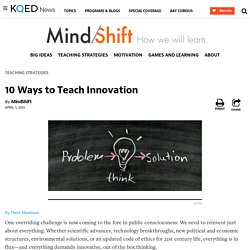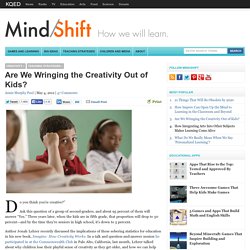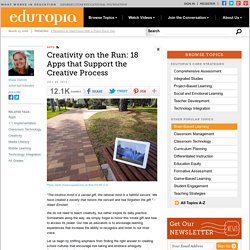

10 Ways to Teach Innovation. Getty By Thom Markham One overriding challenge is now coming to the fore in public consciousness: We need to reinvent just about everything.

Whether scientific advances, technology breakthroughs, new political and economic structures, environmental solutions, or an updated code of ethics for 21st century life, everything is in flux—and everything demands innovative, out of the box thinking. The burden of reinvention, of course, falls on today’s generation of students. So it follows that education should focus on fostering innovation by putting curiosity, critical thinking, deep understanding, the rules and tools of inquiry, and creative brainstorming at the center of the curriculum. This is hardly the case, as we know. Move from projects to Project Based Learning. Teach concepts, not facts. Distinguish concepts from critical information. Make skills as important as knowledge.
Form teams, not groups. Use thinking tools. Use creativity tools. Reward discovery. Be innovative yourself. Related. Are We Wringing the Creativity Out of Kids? Do you think you’re creative?”

Ask this question of a group of second-graders, and about 95 percent of them will answer “Yes.” Three years later, when the kids are in fifth grade, that proportion will drop to 50 percent—and by the time they’re seniors in high school, it’s down to 5 percent. Author Jonah Lehrer recently discussed the implications of these sobering statistics for education in his new book, Imagine: How Creativity Works. In a talk and question-and-answer session he participated in at the Commonwealth Club in Palo Alto, California, last month, Lehrer talked about why children lose their playful sense of creativity as they get older, and how we can help them hang on to it. Lehrer began by quoting Picasso: “Every child is born an artist. “Right now we are grooming our kids to think in a very particular way, which assumes that the right way to be thinking is to be attentive, to stare straight ahead.”
Related. Ken Robinson: How schools kill creativity. Creativity on the Run: 18 Apps that Support the Creative Process. "The intuitive mind is a sacred gift, the rational mind is a faithful servant.

We have created a society that honors the servant and has forgotten the gift. " - Albert Einstein We do not need to teach creativity, but rather inspire its daily practice. Somewhere along the way, we simply forgot to honor this innate gift and how to access its power. Our role as educators is to encourage learning experiences that increase the ability to recognize and listen to our inner voice. Let us begin by shifting emphasis from finding the right answer to creating school cultures that encourage risk-taking and embrace ambiguity. The Idea Catcher We can start by using note-taking apps to encourage observation and reflection.
Useful apps are those that encourage the recording of our thought flow and merge text with features such as voice recording, video, sketching and photography. Recommended apps: Tricking the Muse A strategy often used to help generate ideas is brainstorming. Brainstorming Let's Get Visual. On the Edge of Chaos: Where Creativity Flourishes. Getty If it’s true, in Sir Ken Robinson’s words, that “Creativity is not an option, it’s an absolute necessity,” then it’s that much more imperative to find ways to bring creativity to learning.

But first, we have to understand what conditions foster true creativity. One definition that scientists have agreed upon for creativity is the ability to create something that’s both novel as compared to what came before, and has value. “It’s this intersection of novelty and value, a combination of those two features that’s particularly important,” Dr. Robert Bilder, a psychiatry and psychology professor at UCLA’s Semel Institute for Neuroscience and Human Behavior. “The truly creative changes and the big shifts occur right at the edge of chaos,” Bilder said. For educators who have embraced the notion of the tightly controlled classroom, it’s a worst-case scenario. It’s the lack of this type of freedom that has led skeptics to question if today’s schools could ever inspire true creativity. Related.